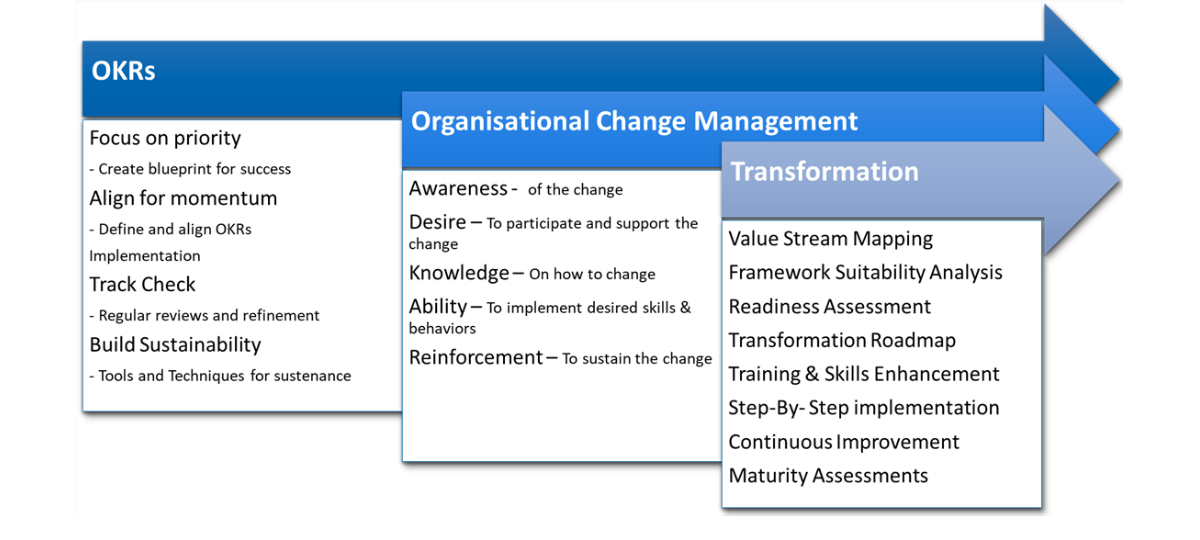Objective Key Results – Navigator for Digital Transformation
In most transformations, Objective Key Result (OKR) is either missing or not effectively implemented, leading to a massive failure. It’s been seen that there are gaps in identifying OKRs their implementation, and periodic reviews. The OKRs are not getting communicated within the organization.
A 2016 Forbes assessment predicted that 84% of digital transformation projects would fail. McKinsey, BCG, KPMG, and Bain & Company estimate that the risk of failure ranges from 70% to 95% [1]. Four years later, even when leadership was in sync, a startling 70% of digital transformation projects failed to achieve their objectives, according to a 2020 study by Boston Consulting Group.
We are advanced in technology with AI/ML leverage and have adopted agile ways of working that are supported by well-defined frameworks, accelerators, etc.
Then where are we going wrong?
Below are the nine mistakes people make in Digital Transformation: [2]
- Not judging the true scope of digital transformation
- Assuming that digital change is just another operating model change
- Cascading disassociation behavior throughout the hierarchy
- Unclear goal and vision for digital transformation
- Unstructured investments focused only on immediate results
- Fixed mindset
- Getting caught up in a spiral of analysis paralysis
- Falling over the hype of the ‘next big thing’ rather than inventing never-before solutions
- Letting culture act as a barrier
Did you notice none of these have anything to do with technology modernization? It’s the people who are getting in the way.
So that means humans are the problem. And the Solution.
Organizations are thinking about digital transformation, enhancing customer experience, technology upgrade/modernization, business agility, innovation, and so on. There are internal as well as external factors that influence organizations to adapt to change. Internal factors like people, processes, tools, technology, structure, and roles, while external factors are political, environmental, social, technological, environmental, and legal.
To reach this north star of digitally transformed organizations, they must:
- Empower people who will drive the digital transformation
- Ensure alignment with business outcomes
- Give joint ownership of organizational goals/strategy
- Focus on innovation than micromanagement or mismanagement of agile teams
- Create the desire for change
- Imbibe the “Fail-fast-learn” culture
- And the critical aspect is the Reinforcement of the change.
OKRs can help when it comes to prioritizing tasks and approaching the digitalization process in a structured and sustainable manner by setting clear goals, building awareness, transparency, and buy-in from stakeholders as well as teams for the change – the adoption of new ways of working.
Why OKR is important to drive any transformation/change is answered by Bono:
The OKR framework cultivates the madness, the chemistry contained inside it. It gives us an environment for risk, and trust, where failing is not a fireable offense. And when you have that sort of structure and environment, and the right people, magic is around the corner.” — Bono, U2 [3]
The organization must develop an integrated strategy with clear transformation goals. The strategy should describe the why, the what, and the how, which are tied to specific, quantified business outcomes, defining the OKRs, OCM model, and, finally, the initiatives to drive the transformation.

Let’s see some more details about Objective-Key Results (OKRs):
OKR is a goal management and execution framework with a maximum of 5 objectives and 3-5 key results associated with each objective.
Objectives are primarily significant, action-oriented, inspiring, concrete, and aligned to vision/strategy. Key results are essentially KPIs with targets and are a measurement of success. Each OKR also has at least one initiative.

The OKRs can be implemented by following the four steps from the OKR Framework:

The OKRs enable organizations to stay relevant and responsive to achieve exponential growth through 6 superpowers:
- More focus on priority
- Greater alignment of goals and efforts
- Value creation
- More interdependencies/collaboration
- Rapid innovation and accountability
- Ownership
Implementing OKRs requires a culture of achievement orientation, encouragement, cooperation, psychological safety, curiosity, and creativity.
Organizations are still learning about the power of OKRs and could possibly take some precautions like:
- Link OKR to the organizational purpose or strategy
- Make Key Results measurable or outcome-focused
- Aligning OKRs instead of cascading OKRs top-down
- Having OKRs that fit with the current corporate culture
- Implementing OKRs with an understanding of the change management process.
In all these transformations, people (62% of employees who do not like leaving their comfort zone) are the common factor for achieving intended outcomes—which is why we need “change management.” Organization Change Management (OCM) also supports the OKRs to play a crucial role in the overall transformation of the organizations.
Conclusion
Undoubtedly, the most challenging part of digital transformation is the human side of change. However, successful transformation requires more than installing the technology, coaching, and development to help people use technological solutions effectively. The mindset toward innovative technological solutions is at the heart of transformation. This means understanding the need for change, its adoption, and promoting its use in daily routine. However, this is difficult to achieve and calls for consistent effort.
Making transformation successful lies in bringing in a cultural shift, which can be achieved by setting and implementing OKRs with people through the change management channels.
More from Mahesh Bondre
Latest Blogs
he supply chain is a network of suppliers, factories, logistics, warehouses, distributers and…
Introduction What if training powerful AI models didn’t have to be slow, expensive, or data-hungry?…
Pharmaceutical marketing has evolved significantly with digital platforms, but strict regulations…
Leveraging the right cloud technology with appropriate strategies can lead to significant cost…




